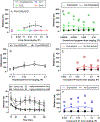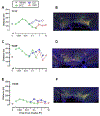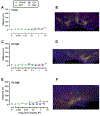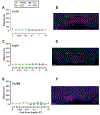Comparison of three DREADD agonists acting on Gq-DREADDs in the ventral tegmental area to alter locomotor activity in tyrosine hydroxylase:Cre male and female rats
- PMID: 37722510
- PMCID: PMC10918529
- DOI: 10.1016/j.bbr.2023.114674
Comparison of three DREADD agonists acting on Gq-DREADDs in the ventral tegmental area to alter locomotor activity in tyrosine hydroxylase:Cre male and female rats
Abstract
Rationale: Despite the increasingly pervasive use of chemogenetic tools in preclinical neuroscience research, the in vivo pharmacology of DREADD agonists remains poorly understood. The pharmacological effects of any ligand acting at receptors, engineered or endogenous, are influenced by numerous factors including potency, time course, and receptor selectivity. Thus, rigorous comparison of the potency and time course of available DREADD ligands may provide an empirical foundation for ligand selection.
Objectives: Compare the behavioral pharmacology of three different DREADD ligands clozapine-N-oxide (CNO), compound 21 (C21), and deschloroclozapine (DCZ) in a locomotor activity assay in tyrosine hydroxylase:cre recombinase (TH:Cre) male and female rats.
Methods: Locomotor activity in nine adult TH:Cre Sprague-Dawley rats (5 female, 4 male) was monitored for two hours following administration of d-amphetamine (vehicle, 0.1-3.2 mg/kg, IP), DCZ (vehicle, 0.32-320 µg/kg, IP), CNO (vehicle, 0.32-10 mg/kg), and C21 (vehicle, 0.1-3.2 mg/kg, IP). Behavioral sessions were conducted twice per week prior to and starting three weeks after bilateral intra-VTA hM3Dq DREADD virus injection.
Results: d-Amphetamine significantly increased locomotor activity pre- and post-DREADD virus injection. DCZ, CNO, and C21 did not alter locomotor activity pre-DREADD virus injection. There was no significant effect of DCZ, CNO, and C21 on locomotor activity post-DREADD virus injection; however, large individual differences in both behavioral response and receptor expression were observed.
Conclusions: Large individual variability was observed in both DREADD agonist behavioral effects and receptor expression. These results suggest further basic research would facilitate the utility of these chemogenetic tools for behavioral neuroscience research.
Keywords: Clozapine N-oxide; Compound 21; DREADD; Deschloroclozapine; Locomotor activity; TH:Cre rats.
Copyright © 2023 Elsevier B.V. All rights reserved.
Conflict of interest statement
Conflicts of Interest
The authors have no conflicts of interest to declare.
Figures




Similar articles
-
Does chronic systemic injection of the DREADD agonists clozapine-N-oxide or Compound 21 change behavior relevant to locomotion, exploration, anxiety, and depression in male non-DREADD-expressing mice?Neurosci Lett. 2020 Nov 20;739:135432. doi: 10.1016/j.neulet.2020.135432. Epub 2020 Oct 17. Neurosci Lett. 2020. PMID: 33080350
-
Validation of DREADD agonists and administration route in a murine model of sleep enhancement.J Neurosci Methods. 2022 Oct 1;380:109679. doi: 10.1016/j.jneumeth.2022.109679. Epub 2022 Jul 30. J Neurosci Methods. 2022. PMID: 35914577 Free PMC article.
-
Behavioral and slice electrophysiological assessment of DREADD ligand, deschloroclozapine (DCZ) in rats.Sci Rep. 2022 Apr 21;12(1):6595. doi: 10.1038/s41598-022-10668-0. Sci Rep. 2022. PMID: 35449195 Free PMC article.
-
A head-to-head comparison of two DREADD agonists for suppressing operant behavior in rats via VTA dopamine neuron inhibition.Psychopharmacology (Berl). 2023 Oct;240(10):2101-2110. doi: 10.1007/s00213-023-06429-0. Epub 2023 Aug 2. Psychopharmacology (Berl). 2023. PMID: 37530882 Free PMC article.
-
Effects of clozapine-N-oxide and compound 21 on sleep in laboratory mice.Elife. 2023 Mar 9;12:e84740. doi: 10.7554/eLife.84740. Elife. 2023. PMID: 36892930 Free PMC article.
Cited by
-
Sex-specific maladaptive responses to acute stress upon in utero THC exposure are mediated by dopamine.Pharmacol Res. 2024 Dec;210:107536. doi: 10.1016/j.phrs.2024.107536. Epub 2024 Nov 30. Pharmacol Res. 2024. PMID: 39622370 Free PMC article.
References
-
- Armbruster BN, Li X, Pausch MH, Herlitze S, Roth BL. Evolving the lock to fit the key to create a family of G protein-coupled receptors potently activated by an inert ligand. Proceedings of the National Academy of Sciences of the United States of America 2007;104:5163–8. 10.1073/pnas.0700293104. - DOI - PMC - PubMed
-
- Boekhoudt L, Omrani A, Luijendijk MCM, Wolterink-Donselaar IG, Wijbrans EC, van der Plasse G, et al. Chemogenetic activation of dopamine neurons in the ventral tegmental area, but not substantia nigra, induces hyperactivity in rats. European Neuropsychopharmacology 2016;26:1784–93. 10.1016/J.EURONEURO.2016.09.003. - DOI - PubMed
Publication types
MeSH terms
Substances
Grants and funding
LinkOut - more resources
Full Text Sources

